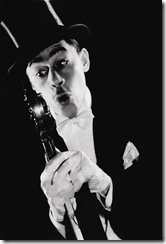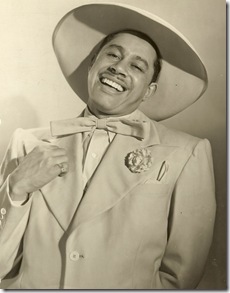Cab Calloway enjoyed new fame in 1980 with the release of The Blues Brothers, directed by John Landis. By which time, he had largely been forgotten. In Cab Calloway: Sketches [PBS, American Masters, 10/9C], Landis is but one of many who reflect on Calloway and his music style charged a generation and influenced many more.
Gail Levin’s Cab Calloway: Sketches isn’t what you would call a biography. It’s more of a collection of reflections and reminiscences that chart his progression as a musician, entertainer and innovator.
Interview subjects – from Calloway’s daughters Cecilia and Camay to Gerald Wilson [noted horn player], from writer Stanly Crouch to dancer/choreographer Matthew Rushing, from writer/critic Gary Giddens to artist Steve Brodner and director Landis – talk about how Calloway went from a loser in a band contest at the Savoy Ballroom to the first black artist to chart a number one hit in the early thirties, and how his sound was unlike anything else at the time – and how it broke the established rules for hit making.
Anyone who’s heard Calloway wailing on Minnie the Moocher, knows that he had a supple voice, good range and a unique delivery. What they might not know is that the song flouted the establishment to become that first number one hit by an African-American artist. Y’see, conventional wisdom said that a hit must be a happy, positive song performed in a major key, but Minnie, of course, is a dark song about sex, drugs, violence and unhappy endings sung in a minor key.
A section of Sketches also notes that Calloway’s older sister was also very talented. She became the first woman – let alone the first Black woman – to front a band. She wrote a song called Growlin’ Dan, and you can hear it echoed in Minnie the Moocher, just as Minnie is echoed in a number of other Calloway compositions, especially Smokey Joe, which is one of a number of songs that comprise what could be considered a suite [I believe it’s Gary Giddens who makes this reference].
Giddens, who for all intents and purposes is the film’s main voice, also notes that Calloway inhabited a unique space in between Duke Ellington and Louis Armstrong in the blossoming of what has come to be referred to as the Harlem Renaissance.
Calloway’s grandson, bandleader C. Calloway Brooks details the disparate and very international elements that came together in his grandfather’s zoot suits, and gives a deft analysis of how Cab’s music was different from anything else at the time [the bass played a split second ahead of the beat, the drums held to middle of the beat, and the saxes came in a split second after the beat]. He also notes of Calloway scatting, that Calloway could get more jazz out of his throat than any of his band members could get from their instruments – and they were all exceptional players.
From Calloway’s daughters, we get a sense of Calloway’s personality and presence [a healthy bit of arrogance; a unique scent acquired from the places he where played and lived].
Landis provides some anecdotes from The Blues Brothers shoot, while session legends and members of The Blues Brothers Band Steve Cropper [guitarist], Duck Dunn [bass] and Lou Marini [sax] reminisce about Calloway and what it was like to play with him.
Giddens also talks about Calloway’s influence on the Fleischer Brothers – who were Disney’s only real competitors – and how they filmed him to rotoscope one of a character in one of their cartoons. That foreshadows the final sequence of the film. Also figuring in that sequence is a painting by Steve Brodner that the film keeps cutting to.
Rushing talks about seeing films of Calloway performing and notes that, though untrained, Calloway’s dancing utilized techniques that are part of modern dance today – which leads into that final sequence in which Brodner’s painting comes to life and the two dance a duet.
Cab Calloway: Sketches makes a good case for the possibility that Calloway would have returned to the public consciousness even without Landis’ 1980 film, simply on the merit of his unique music – without ever coming right out and saying so. It certainly gives him his due for his musical innovation and spirit.
He was definitely an original, as is Cab Calloway: Sketches.
Final Grade: A
Photos courtesy of PBS


